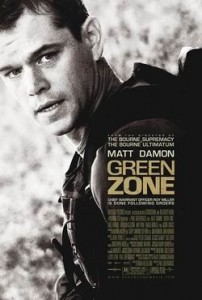Iraq 2003. The “shock and awe” party is in full effect, tracer fire lights up the night sky and concussion blasts from “smart” bombs shake gilded masonry into the lap of the movie theatre. Fleeing from the chaos is Saddam’s top General, Al Rawi, flanked by bodyguards and whisked away in a blacked out limo.
Four weeks later and Chief Miller has a headache. While the American brass congratulates one another on a job well done, Miller has to deal with the hangover. He’s charged with finding WMDs but there’s one problem-Miller and his team are coming up short. Is the Intel out of date, bad or just a pack of lies?
Paul Greengrass’ million-mile-an-hour thriller delivers. Is there anyone better at handling smart-actioners than the “Bourne” director? So what if he’s teamed up with Damon again-did anyone question Scorsese for using De Niro so many times? Why not embrace the fact that this partnership is unleashing some of the best action set pieces since Lucas and Spielberg signed up the young Harrison Ford?
What is beyond question is the film’s powerful vision of Iraq as a country teetering on the brink of catastrophe. Various American agencies jockey for position, each establishing their own fiefdom in their Disneyland version of Baghdad-the eponymous Greenzone. The CIA and the Pentagon are at each others throats, using the military as pawns in their struggle to decide who will “manufacture democracy” in the new Iraq.
Miller is questioning the intelligence reports that are sending his team on a wild goose chase. Both sides want to get their claws into the Chief after he uncovers a vital notebook that might just stop the insurgency. Either that, or it will blow the lid on a vast Government conspiracy that will take everybody down with it. Will Miller side with the old school CIA, or the new school interns of the Pentagon?
This tug-of-war also calls into question the seduction of the media by the Bush administration and its part in selling the war to the American public. Were they guilty of being glamoured by the promise of exclusive stories and not checking their sources scrupulously? Was the lure of the imbedded reporter too good an opportunity to turn down, and can Miller’s information offer the press a slim chance of redemption?

The other striking aspect of the film is its use of the doublespeak so intrinsically linked with this shambolic conflict. Miller is constantly “off reservation,” needs to discuss his concerns “offline,” and the Pentagon deploys “local assets” to stop him. Even the military have a “detailed media plan” of how they will break the news when WMDs are discovered, “Something they can hold up on CNN.”
“Green Zone” fights on many fronts and wins them all. Greengrass effortlessly shuffles political intrigue and recent history with a rip-roaring yarn that never comes up for air. Assault rifles chatter, grenades explode, and the most sinister helicopters this side of “Apocalypse Now” scream overhead. Spilling out of the Blackhawks is Jason Isaacs, chewing scenery and spitting bullets, and proving, as always, that a film with him in is always better than one without.
“It’s not for you to decide what happens here,” Miller is told by his Iraqi translator. Yet the final shot proves otherwise. As the CIA boss Martin Brown might say, “Don’t be so naive.”

One thought on ““Green Zone”: Greengrass & Damon do it again”
Comments are closed.